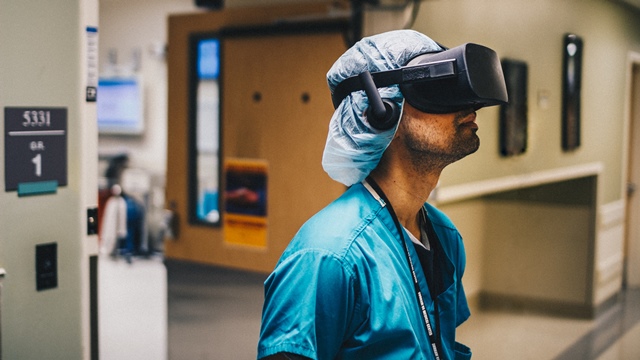
By Brian Conyer
Over the last decade, there have been two significant advancements in the way people experience video content. The first is that streaming media OTT platforms have made consuming content easily accessible across all connected devices. The second is the mass commercialization of virtual reality technologies that fully immerses consumers into virtual environments. Despite VRs slower than expected adoption in consumer-driven industries such as gaming and entertainment, analysts are extremely optimistic about the clear benefits the technology offers in healthcare and education. Grandview Research estimates the healthcare Virtual Reality (VR) and Augmented Reality (AR) markets will be a $5.1 billion industry by 2025, and medical education will represent a sizeable portion of that.
With medical information and innovations growing at alarming rates, physicians must master more information in shorter time frames than their predecessors. The vast improvements of streaming media and fully immersive virtual reality technologies will fundamentally change the way medical professionals access and engage with educational materials. Virtual conferences and operating room experiences will provide unprecedented access to the most renowned physician leaders and will significantly reduce the cost of travel, conference fees, and missed work days that physicians currently incur to keep abreast the rapid influx of information in medicine.
Streaming influence in medical education
Although the quality and volume of clinical evidence in modern medicine are abundant, the delivery mechanisms of this information remain outdated. This includes traditional print publications, antiquated websites with poorly designed user interfaces, and low-quality user-generated videos. Knowledge sharing at scale is undoubtedly a major challenge for the medical community, particularly for hospitals and geographies that lack resources, but the adoption of streaming video will ease this burden for the global community.

With thoughtfully produced educational videos leveraging the most cutting-edge video technologies currently available and featuring the foremost subject matter experts, physicians will no longer need to attend to medical conferences or visit the operating rooms of expert surgeons to learn new information. On-demand streaming videos can provide physicians with the most relevant and pertinent information that is packaged to the preferences of the younger generation of doctors. Beyond the scalability and the economic benefits of educational video content for the medical community, this will be the preferred method of consumption because of its inherent accessibility and convenience.
In addition, streaming video also addresses many of the limitations that medical education currently faces. The convenience of on-demand video is better suited for the chaotic and unpredictable schedules of the modern physician. The analytics will help content creators develop better and more engaging content. The ability to stream to any connected device can effortlessly reach a global audience. Lastly, machine learning and predictive algorithms that analyze what viewers consume will further enhance individualized learning experiences.
Virtual reality influence in medical education
While streaming fulfills the promise of accessibility and scalability, it is 360-degree virtual reality that provides the immersive medical education experience. With entertainment, people do not need to watch their favorite movie in VR, whereas in contrast, the immersion of VR delivers a critical element to education. For example, VR creates an authentic operating room environment for those learning new techniques and technologies such as advanced laparoscopy and robotics. With a multitude of camera angles, including surgeon POV, 360-degree panoramic views of the OR, and digital overlays that highlight the surgical procedure, there has never been a better option to experience an authentic OR environment other than physically being present.
Cedars-Sinai is a recent example of the integration of VR in medical education, becoming the first to offer a CME-accredited virtual reality course called the Essential GI Surgeries. The course offers 25 hours of high-definition, fully-narrated surgical procedures featuring the latest in laparoscopic and robotic techniques performed by Cedars-Sinai’s experts. Cedars Sinai is ranked No. 3 in Gastroenterology and GI Surgery by the 2018 Best Hospitals edition of U.S. News & World Report, which means that anyone around the globe can now learn directly from some of the best physicians in the US and also earn continuing medical education credits.
As medical procedures continue to grow in complexity and become more technology-driven, the way medical education is shared and delivered must also keep pace. Streaming media and virtual reality are not a preference, but rather the clear evolution of medical education. Surgeons and physicians can learn from the convenience of their homes, digesting more information with improved context that will ultimately help them provide better patient care.
Brian Conyer is CEO and Co-founder of GIBLIB. GIBLIB is the only streaming media platform to provide medical professionals anywhere in the world access to high-fidelity, immersive 360-degree virtual reality video content of the most current medical topics and sought-after surgical procedures performed by the world’s leading specialists.


